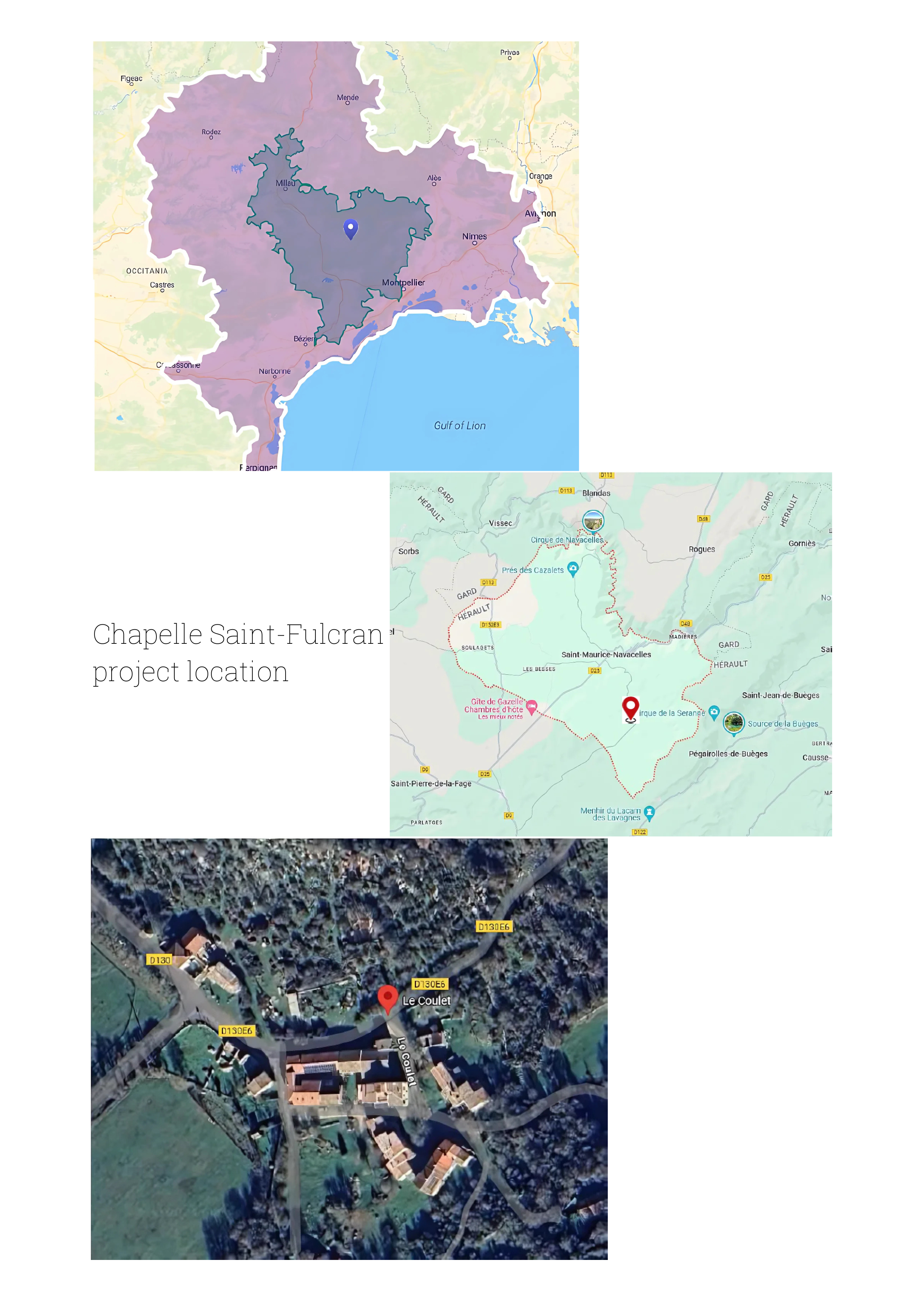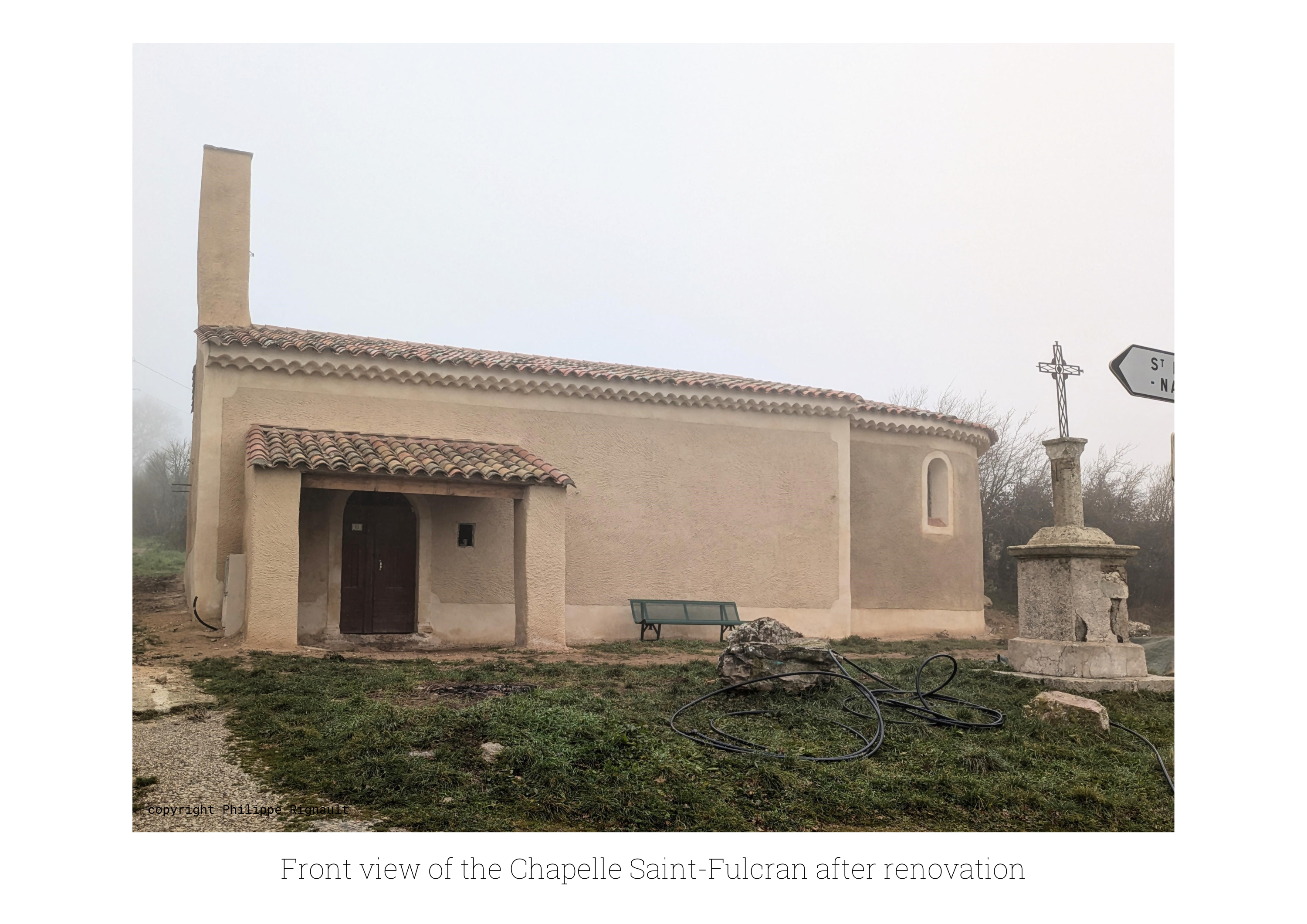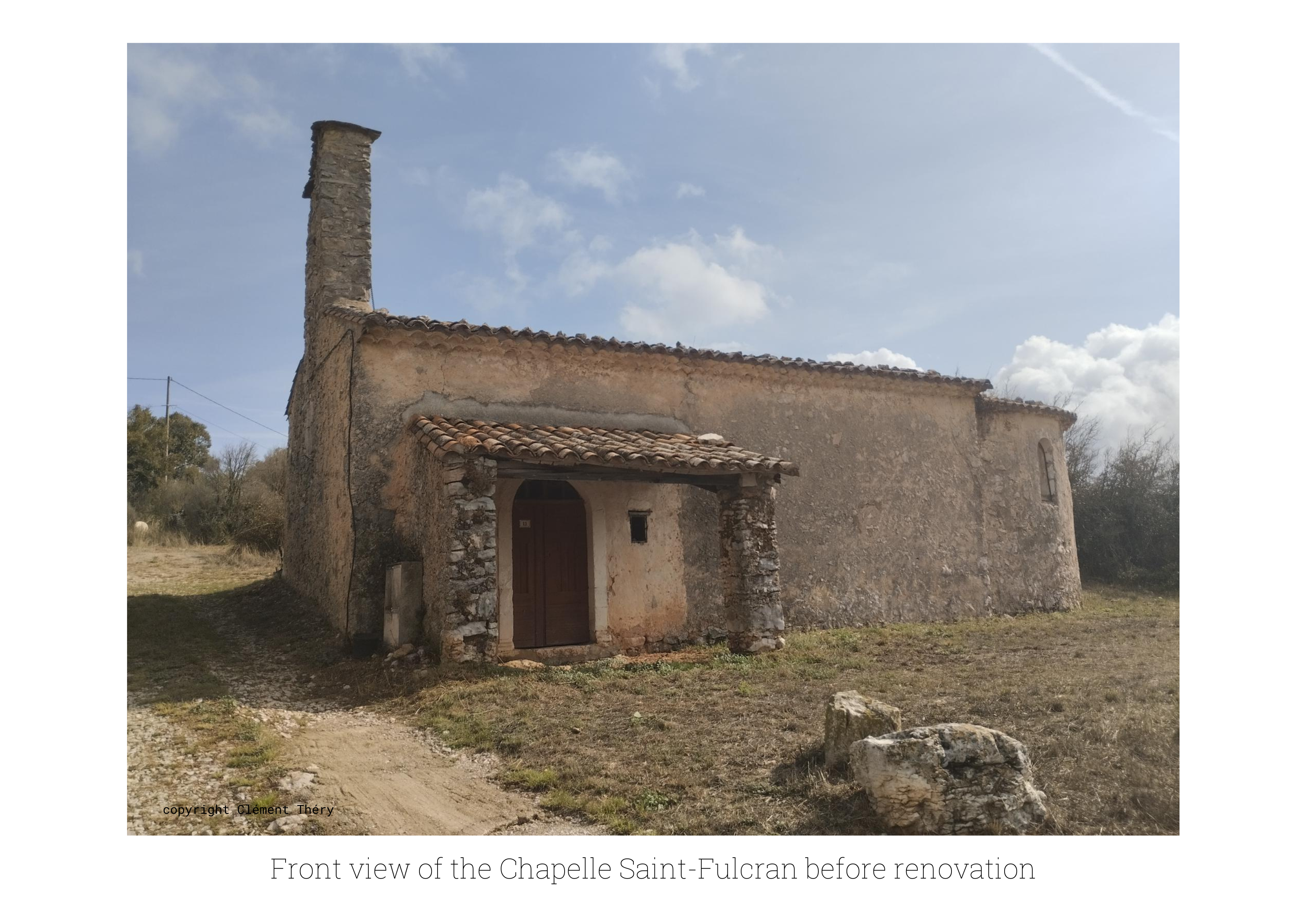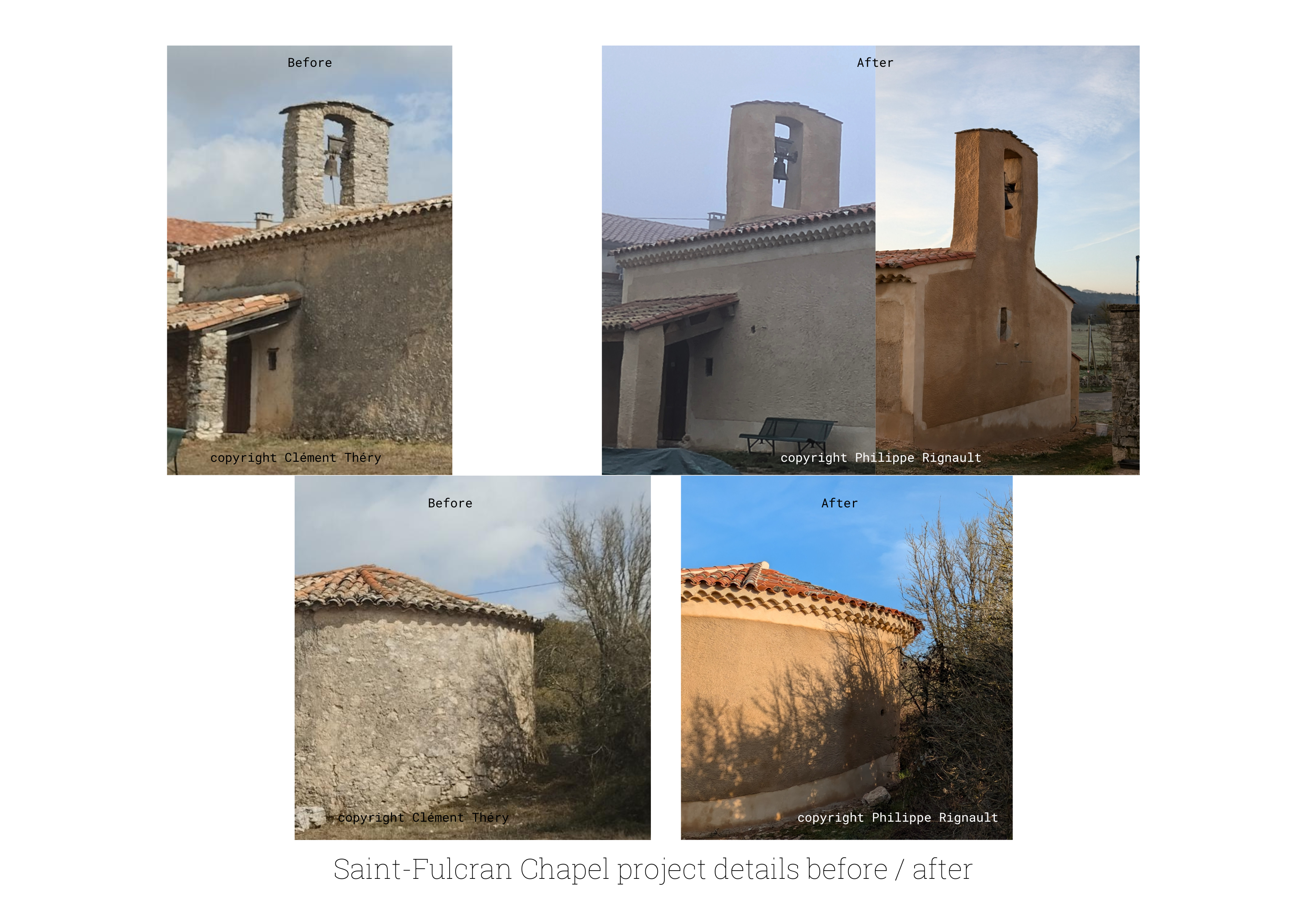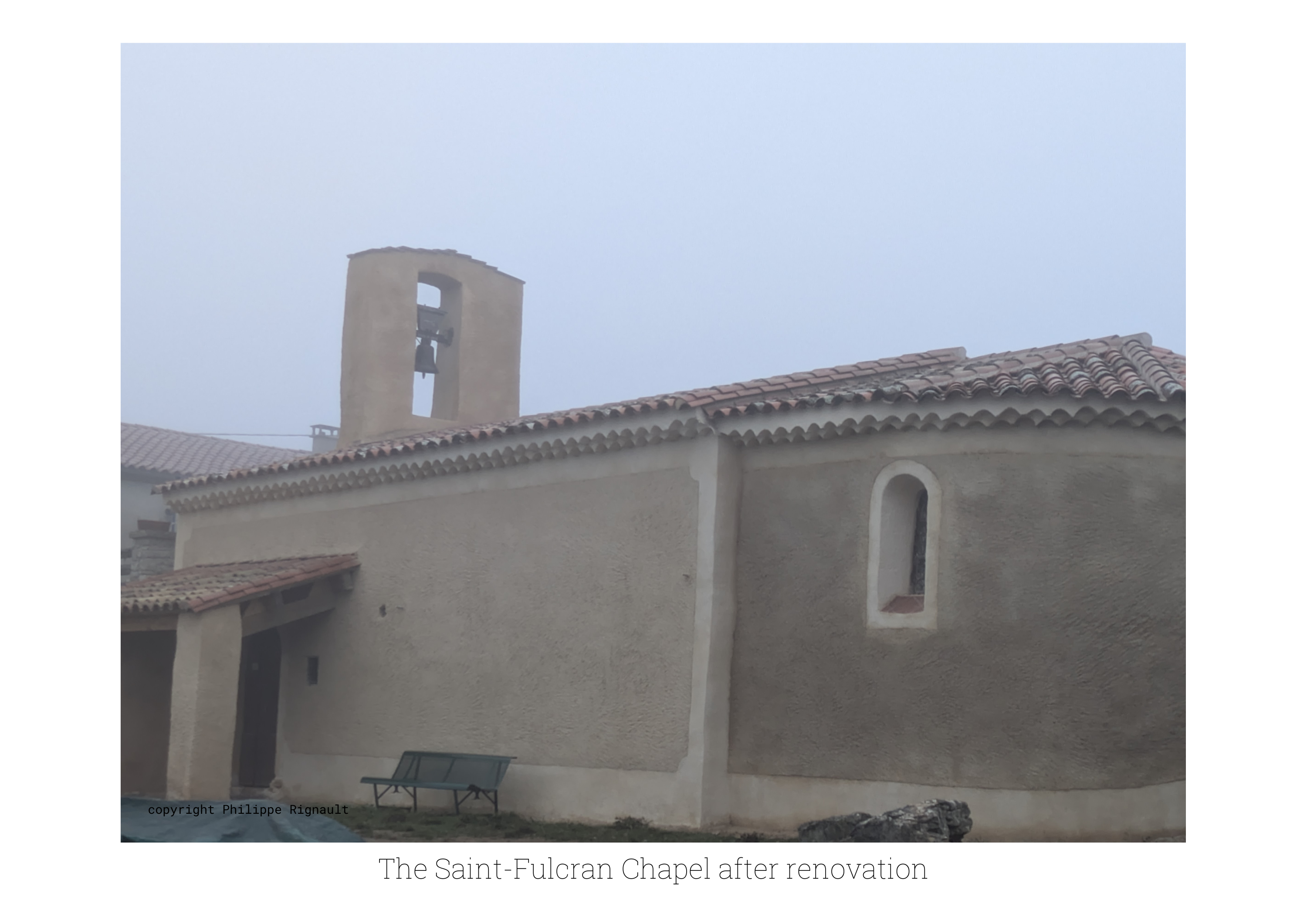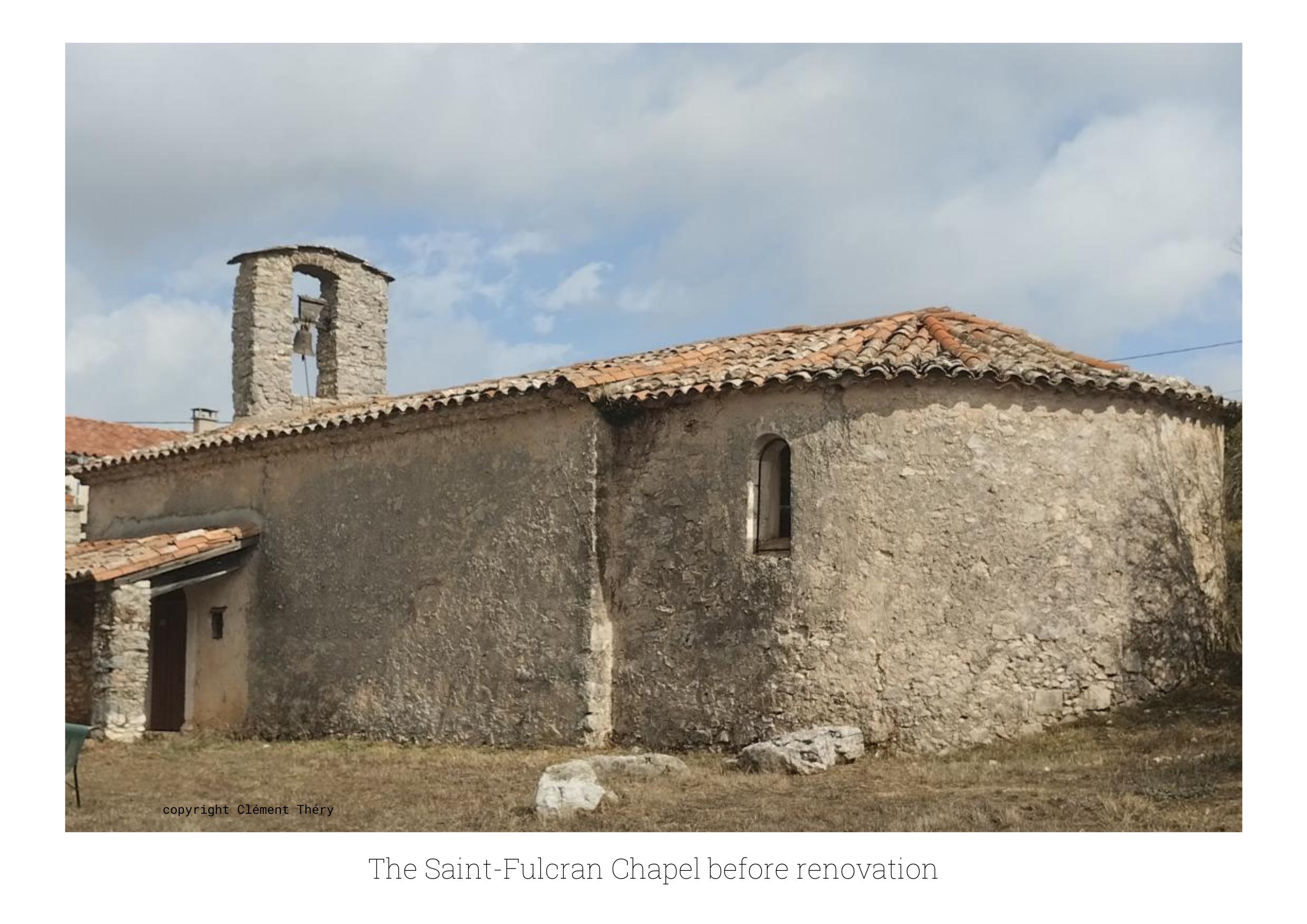A new destiny for the chapel of St Fulcr
A new destiny for the chapel of Saint Fulcran
A chapel that had fallen into disuse on the Larzac plateau (southern France) has been brought back to life by being transformed into a gîte for the many walkers on the Chemin de Saint Guilhem. The place, the building and the landscape have regained their power to deliver rest and serenity to all these walkers.
And the chapel, preserved and embellished, has regained its role for the residents and the municipality.
And the chapel, preserved and embellished, has regained its role for the residents and the municipality.
France
{Empty}
Prototype level
Yes
Yes
Yes
No
No
34277: Saint-Maurice-Navacelles (FR)
Saint Maurice Navacelles is a small municipality in southern France (https://www.stmauricenavacelles.fr/) with a population of 184 (2024 census), covering more than 6,000 hectares divided in hamlets, isolated farms and the main village, set in remarkable landscapes and natural areas (UNESCO, Natura 2000, Parc Naturel Régional des Grands Causses, Grand Site de France, Geopark, etc.).
The municipality has a significant built heritage, but it has often been completely neglected for years, making it impossible to take advantage of these protection and enhancement schemes.
We are currently focusing on renovating the Chapelle Saint Fulcran, in the hamlet of Le Coulet, which was officially disused in 2024. This 17th-century chapel is located on a variant of the Routes of Santiago de Compostela, which leads to Saint Guilhem Le Désert. This route is very popular, and there is not enough accomodation for hikers. The conversion of the chapel will meet this need by creating a 12-bed stopover gîte. Architectural, heritage and profitability studies have demonstrated the interest and viability of the project, which will create permanent local employment and generate income for the municipality, two rare opportunities in our isolated regions.
The project began in summer 2022, with the gîte due to open in spring 2026. The exterior of the chapel has been completely renovated and the interior fittings will follow, shared between local craftsmen and the commune's technical department.
The municipality has a significant built heritage, but it has often been completely neglected for years, making it impossible to take advantage of these protection and enhancement schemes.
We are currently focusing on renovating the Chapelle Saint Fulcran, in the hamlet of Le Coulet, which was officially disused in 2024. This 17th-century chapel is located on a variant of the Routes of Santiago de Compostela, which leads to Saint Guilhem Le Désert. This route is very popular, and there is not enough accomodation for hikers. The conversion of the chapel will meet this need by creating a 12-bed stopover gîte. Architectural, heritage and profitability studies have demonstrated the interest and viability of the project, which will create permanent local employment and generate income for the municipality, two rare opportunities in our isolated regions.
The project began in summer 2022, with the gîte due to open in spring 2026. The exterior of the chapel has been completely renovated and the interior fittings will follow, shared between local craftsmen and the commune's technical department.
rural revitalisation
heritage preservation
frugal engineering
sustainable tourism
pragmatism
The restoration of the building, which is sustainable by nature (siting, spatial orientation, construction materials, adaptation to the local climate, etc.), is carried out using traditional techniques and with a great concern for frugal engineering: rendering with lime slaked on site, restoration of the bell tower and the bell yoke, conservation of the volumes and openings, interior infrastructure in wood and iron, insulation and high-performance joinery, pellet-burning stove, etc. The craftsmen chosen are local heritage specialists. The operating model focuses on the use of short circuits for the supply of meals and services. The venue, which will be open all year round, will also be open to local associations and residents for meetings and events, etc.
The redevelopment of the Chapelle Saint Fulcran will enable it to remain part of the village's heritage, respecting the original building, in particular by using old techniques for the exterior rendering and keeping the bell, preserving the symbol for the local population (in particular for the inhabitants of the hamlet of Coulet) and preserving its role as a meeting place.
The redevelopment of the Chapelle Saint Fulcran will enable it to remain part of the village's heritage, respecting the original building, in particular by using old techniques for the exterior rendering and keeping the bell, preserving the symbol for the local population (in particular for the inhabitants of the hamlet of Coulet) and preserving its role as a meeting place.
Without the municipal will to save the Saint Fulcran's chapel, this little church would have continued its slow decline towards inevitable ruin. An open call for expressions of interest was launched in 2023 to gather proposals. This approach led to a shift in the way people looked at this small heritage building. Residents expressed their attachment to the chapel, the memories it represents for their families and their fears about its future. The professional applicants deplored that there was no housing available nearby, as the site was an attractive place to set up their workshops: pottery, glasswork, leatherwork...
Converting the chapel into residential accommodation was neither simple nor ultimately feasible, as it would have required the opening of large windows, distorting the character of the building.
Among the many examples of conversions of religious buildings in small french rural communities, few are open to the public. For the most part, these are cultural venues: exhibitions, media libraries, etc. These solutions were not suited to the context of the Saint Fulcran's chapel.
Transforming the church into a stopover gîte quickly won the support of the local residents, provided it will remained a municipal building and that the external appearance of the church was respected. The Saint Fulcran's chapel is therefore in the process of being ‘recycled’ by society, its heritage quality is being preserved, its appropriation by the residents is natural and the sharing with future users will be simple. Arriving at sunset at the chapel, after a day's walk through the arid landscapes of the Larzac, walkers will experience the ancestral emotion of those who settled their families there, cultivated these capricious lands and settled their herds. They'll understand the people who still live there today and maintain their agro-pastoral activities, which have been honoured by UNESCO.
Converting the chapel into residential accommodation was neither simple nor ultimately feasible, as it would have required the opening of large windows, distorting the character of the building.
Among the many examples of conversions of religious buildings in small french rural communities, few are open to the public. For the most part, these are cultural venues: exhibitions, media libraries, etc. These solutions were not suited to the context of the Saint Fulcran's chapel.
Transforming the church into a stopover gîte quickly won the support of the local residents, provided it will remained a municipal building and that the external appearance of the church was respected. The Saint Fulcran's chapel is therefore in the process of being ‘recycled’ by society, its heritage quality is being preserved, its appropriation by the residents is natural and the sharing with future users will be simple. Arriving at sunset at the chapel, after a day's walk through the arid landscapes of the Larzac, walkers will experience the ancestral emotion of those who settled their families there, cultivated these capricious lands and settled their herds. They'll understand the people who still live there today and maintain their agro-pastoral activities, which have been honoured by UNESCO.
The Saint Fulcran chapel is a 17th century heritage building. The aim of the project is to convert it into a 12-bed stopover gîte for hikers, thereby classifying it as a 5th category Public Access Establishment under French legislation. The technical characteristics of the building, the need to preserve the heritage value of its architecture and the low accommodation capacity entitle it to an exemption from the obligation to bring it up to standards for access by people with disabilities (decree no. 2014-1327 of 5 November 2014). However, it is mainly people in wheelchairs who will be unable to use this gîte without human assistance. Devices to facilitate other types of disability will be put in place as far as possible: obstacle-free interior pathways, homogenous lighting, coloured signage, tactile markers, ramps, etc.
The business model will take particular care to ensure that the gîte is affordable for as many hikers as possible. Different options will be offered to suit the budget of users: bed linen and towels provided or not, meals served at the table or prepared independently, cleaning included or paid for by users, etc. In this way, we hope to help keep hiking a leisure activity open to as many people as possible.
Rental will be free of charge for local associations, and a special rate will apply to residents wishing to use the gîte for family gatherings. The installation of a heating system (wood pellet stove) will make it possible to use the gîte outside the peak tourist season, from November to March.
The business model will take particular care to ensure that the gîte is affordable for as many hikers as possible. Different options will be offered to suit the budget of users: bed linen and towels provided or not, meals served at the table or prepared independently, cleaning included or paid for by users, etc. In this way, we hope to help keep hiking a leisure activity open to as many people as possible.
Rental will be free of charge for local associations, and a special rate will apply to residents wishing to use the gîte for family gatherings. The installation of a heating system (wood pellet stove) will make it possible to use the gîte outside the peak tourist season, from November to March.
Le Coulet is one of the small hamlets in the commune of Saint Maurice Navacelles. In the past, it was home to several farming families and had its own church, cemetery and school. The rural exodus that has hit our countryside since the 14-18 war has changed this image. Today, there are just a handful of permanent residents in the Hameau du Coulet, mainly elderly people who are joined in the summer by family members and holidaymakers. The population of the hamlet may then number around fifteen.
Although few in number, these direct neighbours of the Chapelle Saint Fulcran are the first to take an interest in its future. Many of their families have celebrated christenings, weddings and funerals there. So it was important for the town council to involve them in the project process. The elected representatives therefore met with them to answer all their questions and gather their suggestions and wishes (meetings with elected representatives and residents on 08 August 2022, 26 July 2023 and 31 July 2024). Their support for the project was not difficult to obtain and their fears, which mainly concerned the final appearance of the building and the retention of the bell, were quickly allayed. The future operation of the Gîte de la Chapelle Saint Fulcran is expected to generate economic activity and provide opportunities for people to meet and socialise, all of which are seen as positive for the life and future of the hamlet of Le Coulet.
Although few in number, these direct neighbours of the Chapelle Saint Fulcran are the first to take an interest in its future. Many of their families have celebrated christenings, weddings and funerals there. So it was important for the town council to involve them in the project process. The elected representatives therefore met with them to answer all their questions and gather their suggestions and wishes (meetings with elected representatives and residents on 08 August 2022, 26 July 2023 and 31 July 2024). Their support for the project was not difficult to obtain and their fears, which mainly concerned the final appearance of the building and the retention of the bell, were quickly allayed. The future operation of the Gîte de la Chapelle Saint Fulcran is expected to generate economic activity and provide opportunities for people to meet and socialise, all of which are seen as positive for the life and future of the hamlet of Le Coulet.
The project to convert the Chapelle Saint Fulcran into a stopover gîte has been carried out with complete transparency from the outset.
Local residents have been consulted and kept informed as the project has progressed.
The financial partners (State, Département, Region) are informed of the progress of the work they have funded.
A heritage architect carried out the exterior diagnosis to ensure the quality of the renovation and an interior architect designed the conversion into a 12-bed gîte. All the craftsmen chosen come from the local community, and their work was orchestrated by the town council, which retained control of the project.Technical staff of the community will also be carrying out the final interior fittings: partitions, painting, installing the kitchen, etc.
All the choices for the future running of the gîte have been made taking into account the opinions of hikers' associations, tourism professionals and institutions of preservation of the sites. In October 2024, Hérault Tourisme commissioned a study entitled ‘Rapid appraisal of the Gîte d'étape Eglise du Coulet, guidelines for positioning the project’, which confirmed the possible economic viability of the project and provided guidance on the forms of management that could guarantee its success.
Local residents have been consulted and kept informed as the project has progressed.
The financial partners (State, Département, Region) are informed of the progress of the work they have funded.
A heritage architect carried out the exterior diagnosis to ensure the quality of the renovation and an interior architect designed the conversion into a 12-bed gîte. All the craftsmen chosen come from the local community, and their work was orchestrated by the town council, which retained control of the project.Technical staff of the community will also be carrying out the final interior fittings: partitions, painting, installing the kitchen, etc.
All the choices for the future running of the gîte have been made taking into account the opinions of hikers' associations, tourism professionals and institutions of preservation of the sites. In October 2024, Hérault Tourisme commissioned a study entitled ‘Rapid appraisal of the Gîte d'étape Eglise du Coulet, guidelines for positioning the project’, which confirmed the possible economic viability of the project and provided guidance on the forms of management that could guarantee its success.
To successfully renovate and change the use of the Saint Fulcran chapel, the local authority had to bring together disciplines whose realities and scales are difficult to reconcile. The intelligence of the project management team made it possible to meet these challenges.
Involving local residents, particularly those from the hamlet of Le Coulet, collecting their memories and taking account of local history helped to ensure their support for the project. They were reassured by the choice of craftsmen specialising in heritage buildings, sustainable technical solutions, step-by-step progress without going overboard, and the guarantee that the jobs generated by the activity would serve to secure a member of the local community.
Working with tourism professionals, other accommodation providers in the area and tourist offices, we were able to match the need for additional accommodation on the Route of Saint Guilhem Le Désert with the constraints of restructuring the Chapelle Saint Fulcran: respect for architecture and environment, durability of materials, frugal engineering, business model favouring short circuits, etc.
The project will enable local residents to rediscover their chapel in the renovated building and benefit from the economic spin-offs of running it as a stopover gîte. For the village, it will mean the creation of a permanent job and induced income for the municipality and local farmers, who supply meat, cheese, yoghurt, wine, etc. for the meals served to hikers.
The Gîte d'étape de la Chapelle Saint Fulcran will also restore the appeal of this section of the Route of Saint Guilhem passing through Le Coulet, which had fallen into disuse following the closure of two gîtes due to the retirement of their owners. The risk of over-frequentation of the other routes is reduced and the environment safeguarded, particularly in terms of biodiversity.
Involving local residents, particularly those from the hamlet of Le Coulet, collecting their memories and taking account of local history helped to ensure their support for the project. They were reassured by the choice of craftsmen specialising in heritage buildings, sustainable technical solutions, step-by-step progress without going overboard, and the guarantee that the jobs generated by the activity would serve to secure a member of the local community.
Working with tourism professionals, other accommodation providers in the area and tourist offices, we were able to match the need for additional accommodation on the Route of Saint Guilhem Le Désert with the constraints of restructuring the Chapelle Saint Fulcran: respect for architecture and environment, durability of materials, frugal engineering, business model favouring short circuits, etc.
The project will enable local residents to rediscover their chapel in the renovated building and benefit from the economic spin-offs of running it as a stopover gîte. For the village, it will mean the creation of a permanent job and induced income for the municipality and local farmers, who supply meat, cheese, yoghurt, wine, etc. for the meals served to hikers.
The Gîte d'étape de la Chapelle Saint Fulcran will also restore the appeal of this section of the Route of Saint Guilhem passing through Le Coulet, which had fallen into disuse following the closure of two gîtes due to the retirement of their owners. The risk of over-frequentation of the other routes is reduced and the environment safeguarded, particularly in terms of biodiversity.
In France, more than 40,000 religious buildings belong to local authorities and only 15,000 are protected as historic monuments. Small communes like Saint Maurice Navacelles don't have the resources to maintain all these buildings, which are often only used for worship on very rare occasions. There's no shortage of examples of churches that have been closed, waiting to fall into ruin and be forgotten. Others are simply demolished to free up land for building. And many are sold to private owners, their future escapes the public domain and their shared history comes to an end.
The project to convert Saint Fulcran's chapel into a stopover gîte is therefore highly original for such a small commune and for such a small church isolated from major roads and centres of economic activity. Keeping its exterior intact by renovating it using traditional techniques, preserving its natural surroundings without installing a car park or tarmac access road, restoring the calvary in front of the chapel, respecting the interior volume by keeping the choir at its full height for the convivial space (kitchen and dining), all these actions are unusual in this kind of conversion of a religious building.
But for us, as elected representatives and residents, the most innovative aspect of this project is in the real recycling of the chapel in the community property. The gîte will provide local employment and significant economic spin-offs for our small region. It will be open and welcoming to local residents and visitors all year round. It will be part of the development of sustainable and virtuous tourism, rooted in local history and offering an insider's view of life in our countryside today.
The project to convert Saint Fulcran's chapel into a stopover gîte is therefore highly original for such a small commune and for such a small church isolated from major roads and centres of economic activity. Keeping its exterior intact by renovating it using traditional techniques, preserving its natural surroundings without installing a car park or tarmac access road, restoring the calvary in front of the chapel, respecting the interior volume by keeping the choir at its full height for the convivial space (kitchen and dining), all these actions are unusual in this kind of conversion of a religious building.
But for us, as elected representatives and residents, the most innovative aspect of this project is in the real recycling of the chapel in the community property. The gîte will provide local employment and significant economic spin-offs for our small region. It will be open and welcoming to local residents and visitors all year round. It will be part of the development of sustainable and virtuous tourism, rooted in local history and offering an insider's view of life in our countryside today.
For a small community like Saint Maurice Navacelles, successful projects require a pragmatic approach. The objectives must be realistic and within the municipality's financial possibilities. Whatever the overall amount of the project, public funding cannot exceed 80% of the total, so the commune must always provide the missing 20% from its own resources. It is therefore necessary to proceed step by step, and the redevelopment of the Chapelle Saint Fulcran will be spread over several years. At each stage, the partners are identified and the financial resources are obtained before the work begins.
August 2022 - Meeting with the residents of the hamlet of Coulet
January 2023 - Decision to apply for exterior renovation grants
June 2023 - Architectural diagnosis for the exterior of the chapel
July 2023 - Meeting with residents of the hamlet of Coulet
September 2023 - First call for expressions of interest
December 2023 - Notification of the DETR grant for the exterior
March 2024 - Notification of Departmental grant for the exterior
May 2024 - Architectural study for the interior fit-out
June 2024 - Prefectoral decree of decommissioning
June 2024 - Appraisal of a proposed stopover gîte, financed by Hérault Tourisme and commissioned from Cabinet Alliances
July 2024 - Meeting with the residents of the hamlet of Coulet
August 2024 - Last mass after agreement to decommission the chapel
September 2024 - Re-roofing
October 2024 - Notification of grant from the Region
November 2024 - Renovation of the facades
January 2025 - Decision to apply for grants for interior renovation
January 2025 - Reinstallation of the bell
February 2025 - Installation of new joinery by the company Février
Pending notification of the grants requested for the interior refurbishments, we are planning :
September 2025 - Interior finishing work
April 2026 - Opening of the gîte
August 2022 - Meeting with the residents of the hamlet of Coulet
January 2023 - Decision to apply for exterior renovation grants
June 2023 - Architectural diagnosis for the exterior of the chapel
July 2023 - Meeting with residents of the hamlet of Coulet
September 2023 - First call for expressions of interest
December 2023 - Notification of the DETR grant for the exterior
March 2024 - Notification of Departmental grant for the exterior
May 2024 - Architectural study for the interior fit-out
June 2024 - Prefectoral decree of decommissioning
June 2024 - Appraisal of a proposed stopover gîte, financed by Hérault Tourisme and commissioned from Cabinet Alliances
July 2024 - Meeting with the residents of the hamlet of Coulet
August 2024 - Last mass after agreement to decommission the chapel
September 2024 - Re-roofing
October 2024 - Notification of grant from the Region
November 2024 - Renovation of the facades
January 2025 - Decision to apply for grants for interior renovation
January 2025 - Reinstallation of the bell
February 2025 - Installation of new joinery by the company Février
Pending notification of the grants requested for the interior refurbishments, we are planning :
September 2025 - Interior finishing work
April 2026 - Opening of the gîte
The decline in the number of churchgoers and priests has led to a reorganisation of Catholic worship, particularly in rural areas. One priest is now in charge of around thirty parishes, and masses are said in turn in the churches in the area. The buildings furthest from the main traffic routes have been abandoned. This was the case with the Chapelle Saint Fulcran, and today only 1/3 of rural churches and chapels are still used regularly for worship. Our project to convert the Chapelle Saint Fulcran into a stopover gîte can serve as a model for many small rural communities struggling with the future of their religious buildings. The pragmatism of the step-by-step project methodology used, the way in which the local people and local memory are taken into account, the architectural and development choices that are compatible with budgetary realities, the use of local craft companies for the work, the creation of jobs, the response to an identified tourist need, the use of short circuits for future operations... are all elements that can easily be reproduced and adapted to the realities of many villages. The exercise can also be applied to other types of building, such as isolated farms and barns. We would be delighted to share our experience with future project developers.
It may seem presumptuous to set global objectives for a town with just 184 inhabitants, but the project to redevelop the Chapelle Saint Fulcran, in all its modesty, is very much in line with this approach.
Renovating a building condemned to oblivion to meet the local need for accommodation for hikers meets the objective of Zero Net Artificialization of Soil recommended by the French government. Any new construction would have used up agricultural land, which is all the more precious in our regions because it is poor and scarce.
Opening new accommodation for hikers will help to spread the flow of traffic on the Saint Guilhem le Désert route along a complementary route. In this way, biodiversity will be less disturbed on each section and the environment preserved.
Entrusting work and supplies to local businesses and creating a job to manage the gîte will help maintain local populations and generate own resources for the commune, which are particularly valuable in the current economic climate.
Renovating a building condemned to oblivion to meet the local need for accommodation for hikers meets the objective of Zero Net Artificialization of Soil recommended by the French government. Any new construction would have used up agricultural land, which is all the more precious in our regions because it is poor and scarce.
Opening new accommodation for hikers will help to spread the flow of traffic on the Saint Guilhem le Désert route along a complementary route. In this way, biodiversity will be less disturbed on each section and the environment preserved.
Entrusting work and supplies to local businesses and creating a job to manage the gîte will help maintain local populations and generate own resources for the commune, which are particularly valuable in the current economic climate.
Our project has been in development since the end of 2022. We were informed of the NEB ‘Coup de pouce pour les petites communes’ on 24 January 2025 by the architecture and heritage coordinator of the Communauté des Communes du Lodévois et Larzac. After reading the Guide for applicants, we were convinced that our objectives, our working methods and the overall philosophy of our project were in line with the values and principles of NEB.
Sustainability and aesthetics: maintaining a remarkable building as part of the town's heritage, using traditional techniques to renovate it, preserving the symbolism it represents for the local population (particularly the inhabitants of the hamlet of Coulet) and using frugal engineering throughout the project...
Involving local residents and taking account of the local fabric: regular meetings with the residents of the hamlet of Le Coulet to gather their wishes and fears, choice of companies to carry out the studies and works, projected profitability of the gîte including the use of local farmers to prepare the meals, etc.
Sustainability and aesthetics: maintaining a remarkable building as part of the town's heritage, using traditional techniques to renovate it, preserving the symbolism it represents for the local population (particularly the inhabitants of the hamlet of Coulet) and using frugal engineering throughout the project...
Involving local residents and taking account of the local fabric: regular meetings with the residents of the hamlet of Le Coulet to gather their wishes and fears, choice of companies to carry out the studies and works, projected profitability of the gîte including the use of local farmers to prepare the meals, etc.

